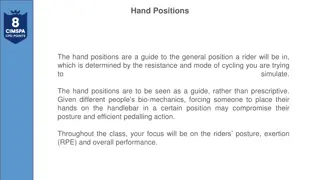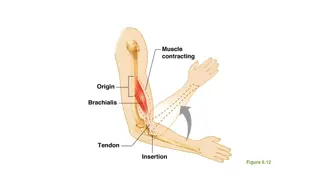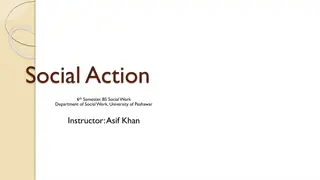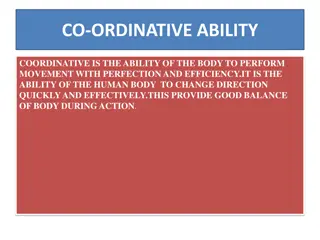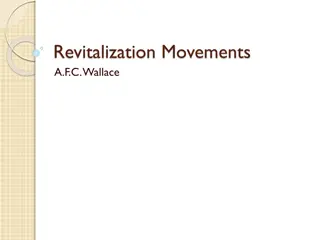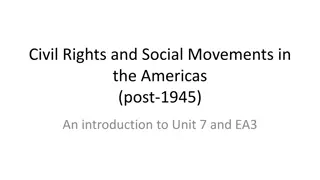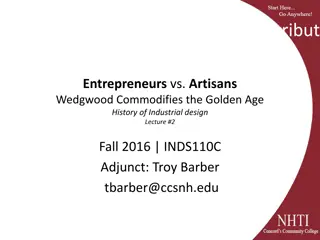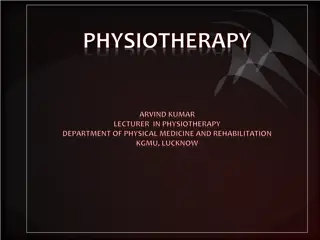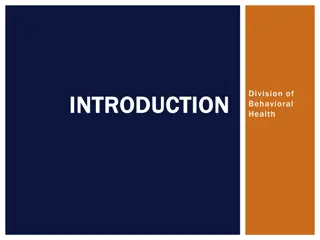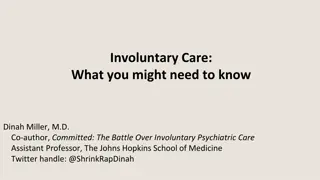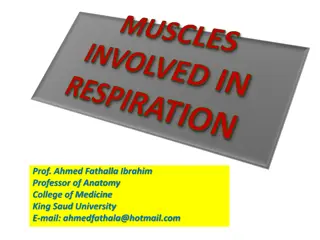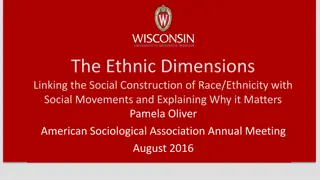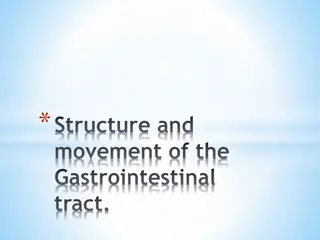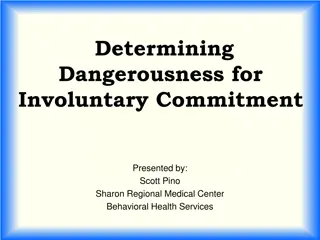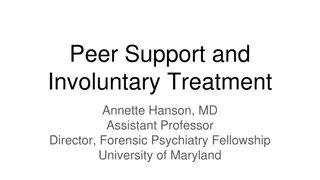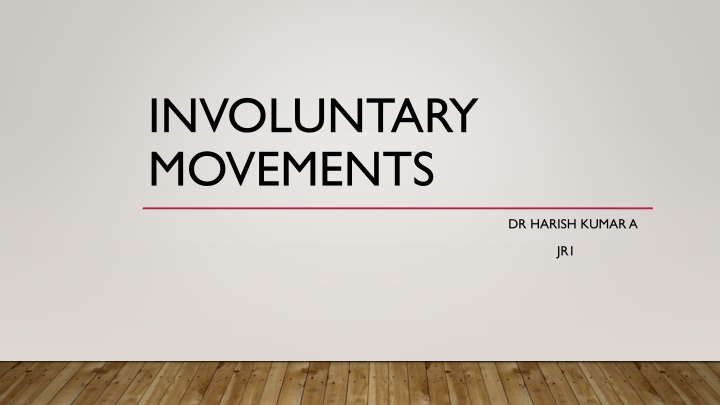
Involuntary Movements and Tremors in Movement Disorders
Explore the world of involuntary movements and tremors in movement disorders like essential tremor and physiological tremor. Learn about the causes, types, symptoms, and treatments for these conditions. Discover how tremors associated with Parkinson's Disease differ and the various treatment options available, including medications and surgical therapies.
Download Presentation

Please find below an Image/Link to download the presentation.
The content on the website is provided AS IS for your information and personal use only. It may not be sold, licensed, or shared on other websites without obtaining consent from the author. If you encounter any issues during the download, it is possible that the publisher has removed the file from their server.
You are allowed to download the files provided on this website for personal or commercial use, subject to the condition that they are used lawfully. All files are the property of their respective owners.
The content on the website is provided AS IS for your information and personal use only. It may not be sold, licensed, or shared on other websites without obtaining consent from the author.
E N D
Presentation Transcript
INVOLUNTARY MOVEMENTS DR HARISH KUMAR A JR1
TREMOR Tremor is defined as involuntary rhythmic oscillatory movement of a body part with alternating contractions of agonist and antagonist muscles Types : Rest tremor: prominent at rest Postural tremor: on assuming a posture Kinetic tremor: on actively reaching for a target Action tremor : on carrying out a movement
PHYSIOLOGICAL TREMOR It manifest as mild, high frequency (10-12 Hz), postural , or action tremor typically affecting the upper extremities 10% of population can have enhanced physiological tremor in association with anxiety, fatigue, hyperthyroidism , drugs( valproate , lithium ) or toxins ( caffeine, smoking , alcohol ) Treatment involves control of underlying disorder and can be improved with beta blockers
ESSENTIAL TREMOR Most common movement disorder High frequency tremor (6-10 Hz ) affecting upper extremities Manifest as action or postural Typically bilaterally symmetrical but can also begin on one side and remain asymmetric
Tremor involves Head in 30% cases, voice in 20%, tongue in 20% ,face/jaw in 10% , and in lower limb 10%. The tremor is characteristically improved by alcohol and worsened by stress
TREATMENT Many cases are mild ; no functional impairment and hence needs only reassurance In severe cases, beta blocker and primidone are standard drug therapies and are useful in about 50% of cases Botulinum toxin may be useful for limb and voice tremor Surgical therapies targeting Ventro-intermediate nucleus of thalamus effective in drug resistant cases
Tremors associated with Parkinson Disease are resting tremors In cerebellar disorder characterized by kinetic tremor associated with hypotonia and past pointing
DYSTONIA Dystonia is a movement disorder characterised by sustained or intermittent muscle contractions of agonist/antagonist muscles causing abnormal, often repetitive movements and postures
CHARACTERISTICS It is initiated or worsened by voluntary action Associated with overflow muscle activation( refers to extension to involve muscle groups and body regions not required for the intended action) It can be aggravated by stress and fatigue and attenuated by relaxation and sensory tricks( like touching the affected body part ) Dystonia can be associated with tremor dystonic tremor which is more pronounced when the body part is moved in the direction of dystonia
CLASSIFICATION Based on clinical and etiological basis Clinical : 1) Age of Onset - infancy , childhood , adolescence , early and late adulthood 2) Body Distribution Focal , segmental , multifocal , and generalised 3) Temporal static or progressive, action specific (diurnal and paroxysmal )
Etiological : 1) Genetic : includes childhood onset and generalised forms of dystonia 2) following Trauma or Stroke
ISOLATED DYSTONIAS Focal, Multifocal, and segmental dystonia Examples include Cervical dystonia ,Blepharospasm , Oromandibular dystonia , Spasmodic dysphonia , limb dystonia Generalised dystonia : hereditary in nature and onset in childhood or adolescence There are 7 well established genes which when mutated would lead to generalised dystonia : TOR1A,THAP1,ANO3,GNAL,KMT2B,PRKRA, and HPCA
COMBINED DYSTONIA Refers to dystonia occurring with a different movement disorder Examples include Segawa syndrome , X linked dystonia-parkinsonism, Myoclonic dystonia Segawa syndrome- Dopa responsive dystonia, GCH 1 gene mutation X-linked dystonia parkinsonism Filipino origin patients, starts as dystonia , generalises and then replaced by l-dopa unresponsive parkinsonism Myotonic dystonia- action induced , alcohol responsive, related to mutation in SGCE gene
COMPLEX DYSTONIA In this dystonia is a part of syndrome ; as if dystonia is the less prominent feature as the disease itself has varied prominent clinical manifestations Hereditary-Wilsons disease , Huntington s disease , Lesh Nyhan Syndrome , corticobasal ganglionic disorders Consequence of Drugs or Toxins usage of neuroleptic drugs , chronic levodopa treatment in PD, manganese or CO toxins Psychogenic origin present with fixed immobile dystonic postures
TREATMENT In young patients , rule out Wilson s disease Childhood dystonia- start levo-dopa to rule out DRD High-dose anticholinergics ( trihexyphenidyl 20-120mg/d) beneficial in children Oral baclofen ( 20-120mg) benefit modest however side effects are problematic(sedation,weakness) Clonazepam and diazepam are also sometimes effective
For focal and segmental dystonia Botulinum toxin is preferred especially for blepharospasm, torticollis, and spasmodic dysphonia Surgical Therapy like DBS of pallidum can provide dramatic benefits for some patients with various forms of hereditary and non hereditary generalised form of dystonia
ATHETOSIS Slow , distal, writhing , involuntary movements with a propensity to affect the arms and hands , toes , feet , neck and tongue This represents a form of dystonia with increased mobility This is due to degeneration of GP of Basal ganglia Most commonly caused by complications at birth(intranatal asphyxia and neonatal jaundice) or by huntington s disease Rarely it is due to trauma or stroke
CHOREAS Huntington s Disease It is characterised by rapid, non patterned , semi purposeful, involuntary choreiform movements Autosomal Dominant disease with age of onset 25-45 years In early stages, chorea tends to be focal or segmental , but progresses to multiple body regions With advancing disease, there is reduction in chorea and emergence of dystonia, rigidity, bradykinesia and myoclonus They develop behavioural and cognitive disturbances and progress to dementia
MRI Disease predominantly affects striatum but progress to involve cerebral cortex and other brain regions Progressive atrophy of the head of caudate nucleus which forms the lateral margin of lateral ventricle is seen on MRI, but putamen can be equally or more severely affected More diffuse cortical atrophy can be seen in middle and later stages of disease
There is no disease modifying therapy for this disorder and symptomatic treatment is limited Deuterated Tetrabenazine approved treatment for chorea in HD Depression and anxiety can be major problems and patient should be treated with appropriate anti depressants and anti anxiety Psychosis should be treated with atypical anti psychotics like clozapine(50- 600mg/d),quetiapine (50-600mg/d) and risperidone ( 2-8mg/d)
OTHER CHOREAS Chorea can be seen in number of additional disorders related to genetic mutations or other disease states Childhood onset chorea- NKX2-1 gene and ADVCY5 gene Chorea-acanthocytosis AR disorder chorea with acanthocytes in blood Sydenham s chorea- develops in association with prior exposure to group A streptococcal infection and is autoimmune in nature Chorea gravidarum in association with pregnancy or treatment with sex hormones
Choreas have been associated with : SLE Hyperthyroidism Sjogren s syndrome Polycythemia vera rubra Drugs- cocaine , CNS stimulants , estrogen , and lithium ,chronic levo dopa treatment in PD
BALLISM/HEMIBALLISMUS Ballism is a violent form of choreiform movement composed of wild, flinging, large amplitube movements most frequently affecting proximal limb muscles on one side of the body ( hemiballism ). Most common cause is a partial lesion (infarct or hemorrhage) in subthalamic nucleus(STN), but in 30-40% of cases the lesion is found in the putamen, thalamus, or parietal cortex Dopamine blocking agents can be used; hemiballismus is usually self limiting and tends to resolve spontaneously after weeks or months In extrme cases , pallidotomy or DBS of GPi can be effective
TICS A tic is a brief, rapid, recurrent, stereotyped, and seemingly purposeless motor contraction. Motor tics- simple ; with movement affecting only single muscle group ( blinking, twitching of the nose , jerking of the neck ) , or complex-co-ordinated movement of multiple muscle group( jumping, sniffing, head banging and echopraxia ) Phonic tics simple(grunting) , complex( echolalia, palilalia , coprolalia ) Sensory tics unpleasant focal sensations in the face, head or neck.
TOURETTES SYNDROME It is a neurobehavioral disorder characterised by motor tics and phonic tics They can voluntarily supress the tics for shorter periods of time ,but then express an irresistible urge to express them Tics vary in intensity and may be absent for days or weeks only to recur in different pattern They present with 2-15 years and tend to lessen with age and even disappear in adulthood
TREATMENT Patients with mild disease often require education and counselling ; in high proportion of patients, tics wane off in adulthood thus arguing for conservative management Drugs are indicated when tics are disabling; clonidine , guanfacine ; both alpha blockers have been tried Atypical neuroleptics like risperidone, olazepine and ziprasidone is tried If they are not working, classical neuroleptics like haloperidol, fluphenazine, pimozide or tiapride
MYOCLONUS Myoclonus is a brief , rapid , shock-like , jerky movement consisting of single or repetitive muscle discharges. It can be focal, multifocal, segmental , generalised or in association with voluntary movement(action myoclonus) or in response to external stimulus ( reflex myoclonus ) Negative myoclonus-brief loss of muscle activity ( asterixis in hepatic failure)
Unlike tics, myoclonic jerks are not repetitive , can severely interfere with normal voluntary movement, and are not suppressible They are found in association with hypoxemia(especially following cardiac arrest), encephalopathy and neurodegeneration. Reversible myoclonus seen in metabolic disturbances ( renal failure, electrolyte imbalance, hypocalcemia ) , toxins and many medications
TREATMENT Managing underlying condition or removing the offending agent Pharmacological therapy involves combining one or more of GABAergic drugs like valproic acid, piracetam, clonazepam, levetiracetam, or primidone DBS highly effective in myoclonic dystonia

